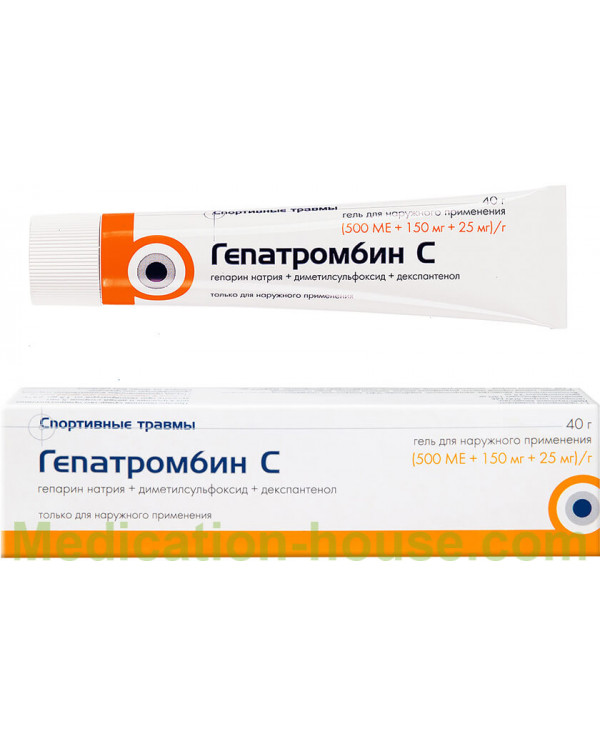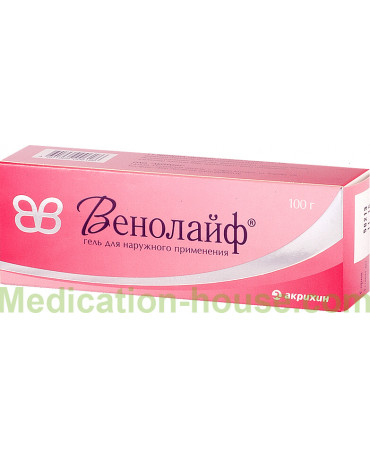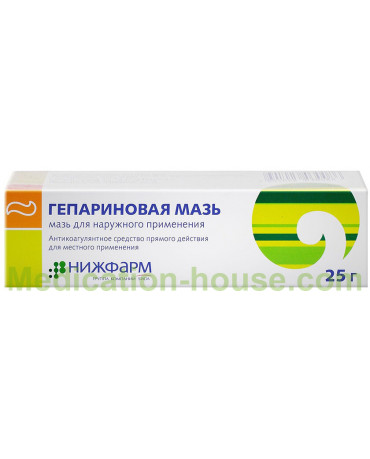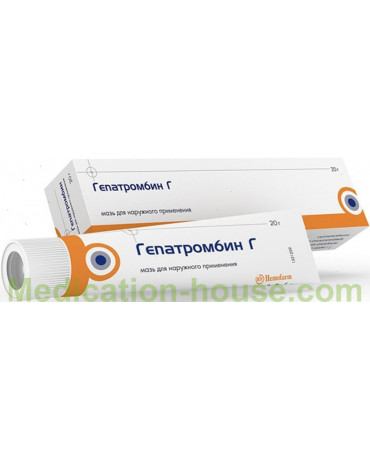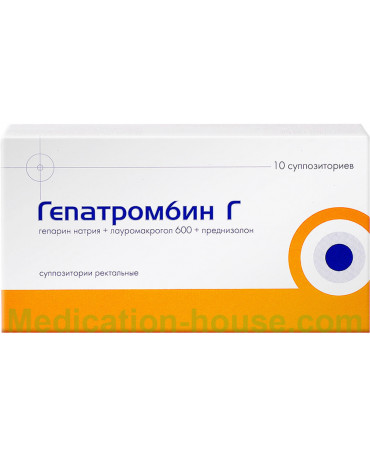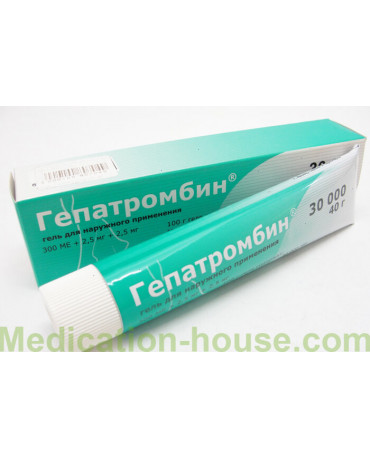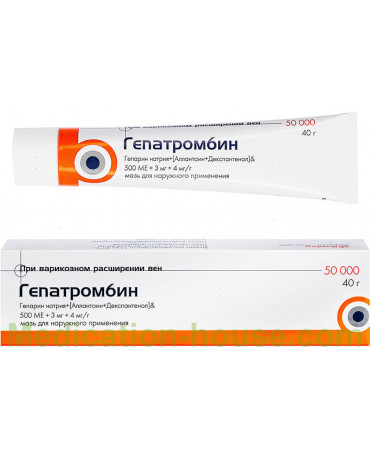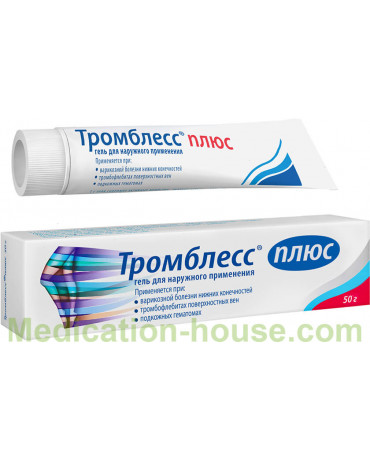Instruction for Hepatrombin C
To buy Hepatrombin C gel just add it to your shopping cart
Composition
1 g of the drug contains:
Active ingredients
Sodium Heparin - 500 ME *, dimethyl sulfoxide - 150.0 mg, dexpanthenol - 25.0 mg;
Excipients
Isopropanol - 353.3 mg, carbomer - 940 - 10.0 mg, macrogol glycerylhydroxystearate - 10.0 mg, trolamine - 5.0 mg, pine mountain oil - 2.5 mg, rosemary oil - 2.0 mg, lemon oil - 0.5 mg, purified water - 438.6 mg.
Pharmacodynamics
Combined preparation for external use. The effect of Hepatrombin C gel is due to its active ingredients.
Heparin sodium - direct acting anticoagulant; due to inactivation of biogenic amines and blocking lysosomal enzymes in tissues, it has an anti-inflammatory effect; accelerates the dissolution of microthrombus in the region of the subcutaneous capillaries; improves local blood flow; promotes the regeneration of connective tissue by inhibiting the activity of hyaluronidase. When applied topically, it also has a anti-edema effect.
Dexpanthenol (provitamin B5) exhibits anti-inflammatory and dermato-protective effect; improving metabolic processes, stimulates regeneration processes. By improving the processes of epithelialization and granulation contributes to the regeneration of damaged tissues.
Dimethyl sulfoxide has anti-inflammatory, local anesthetic, analgesic and antimicrobial action; has moderate fibrinolytic activity. It penetrates the skin, mucous membranes, biological membranes, promotes deeper penetration into the tissues of other components of Hepatrombin C.
Pharmacokinetics of Hepatrombin C
When applied externally, sodium heparin quickly penetrates the skin: 1 hour after application of the gel to the skin, the concentration in the underlying tissues is comparable to that observed after intravenous administration (IV) of 5000 IU of heparin. Heparin does not penetrate the placental barrier and is not excreted in breast milk.
Dexpanthenol - after resorption into the skin turns into pantothenic acid (vitamin B5), which, as part of coenzyme A, is involved in numerous metabolic processes.
Dimethyl sulfoxide quickly penetrates the skin, mucous membranes, biological membranes (including through the membranes of microbial cells). After application to the skin, the maximum plasma concentration is reached after 4-8 hours. Evenly distributed in the body, with the exception of the brain, where its concentration is minimal. Mainly excreted in urine (30% of the dose in the form of unchanged drug and dimethyl sulfone); to a small extent through the lungs and intestines. The metabolite dimethyl sulfide causes a characteristic garlic breath from some patients.
Indications for use
Hematomas, inflammation of the soft tissues, muscles, tendons, tendon sheaths, ligaments after bruises, compression, injuries (including sports).
Peripheral periarthritis, shoulder epicondylitis ("tennis player's elbow"), tendinitis, tendovaginitis, bursitis, deforming osteoarthrosis (in the presence of periarticular tissue damage), neuralgia.
Contraindications for Hepatrombin C
Hypersensitivity to heparin, dimethyl sulfoxide, dexpanthenol and other components of Hepatrombin C gel;
bronchial asthma;
pregnancy, lactation;
severe hepatic and / or renal failure;
severe disorders of the cardiovascular system (including severe angina, myocardial infarction, stroke, severe atherosclerosis);
lupus erythematosus;
open wounds at the site of application;
children's age up to 5 years.
Use during pregnancy and during breastfeeding
Hepatrombin C gel is contraindicated for use during pregnancy and lactation.
Dosage and administration
Outwardly.
The gel is applied with a thin layer to the affected skin or the skin over the painful area, trying to avoid applying Hepatrombin C directly on wounds and abrasions. After applying the gel should not be bandaged. Before applying the skin must be clean and dry. The procedure is repeated 1-2 times a day for 7-10 days or until the symptoms of the disease disappear (pain, swelling, inflammation). If within 10 days of application of the gel does not occur a distinct improvement, it is recommended to consult a doctor.
Side effects
Hyperemia, itching and burning of the skin in the area of application; allergic reactions (urticaria, angioedema); smell of garlic from the mouth; change in taste.
Overdose
To date, cases of overdose of the drug Hepatrombin C is not described. With proper use of the gel, overdose is unlikely.
Interaction with other drugs
Dimethyl sulfoxide contained in the gel significantly enhances the penetration of other drugs through the skin. To prevent the undesirable effects of these substances, other drugs should not be applied to the skin before or after the application of Hepatrombin C.
special instructions
It is not recommended to apply gel on open wounds.
If allergic skin reactions occur, treatment should be discontinued.
Release form
Gel for external use (500 ME + 150 mg + 25 mg) / g.
On 40 g of a preparation in an aluminum tuba, corked by the screw-on lid from plastic. The opening of the tube is protected by an aluminum membrane. The lid is a monolithic structure that includes a device for piercing the membrane. Tuba together with the application instruction in a pack cardboard.
Storage conditions
Store at a temperature of 15 to 25 ° C.
Keep out of the reach of children!
Shelf life - 5 years.
Do not use after the expiration date printed on the package.
Terms of sell
You don't need a prescription to buy Hepatrombin C.

